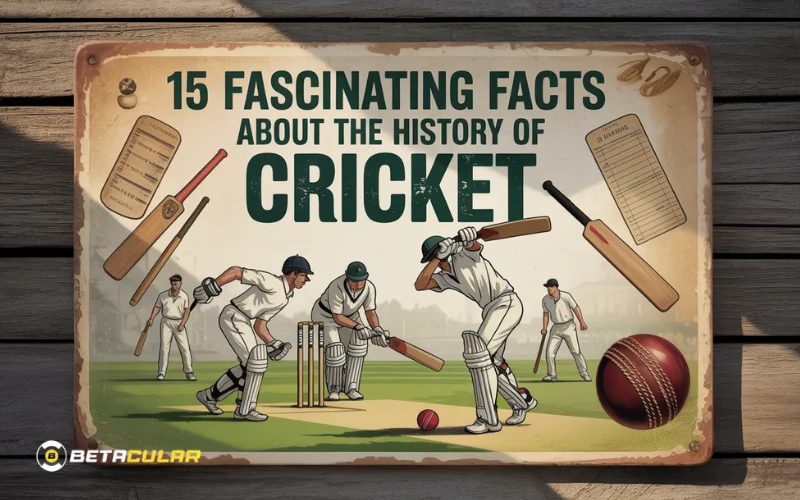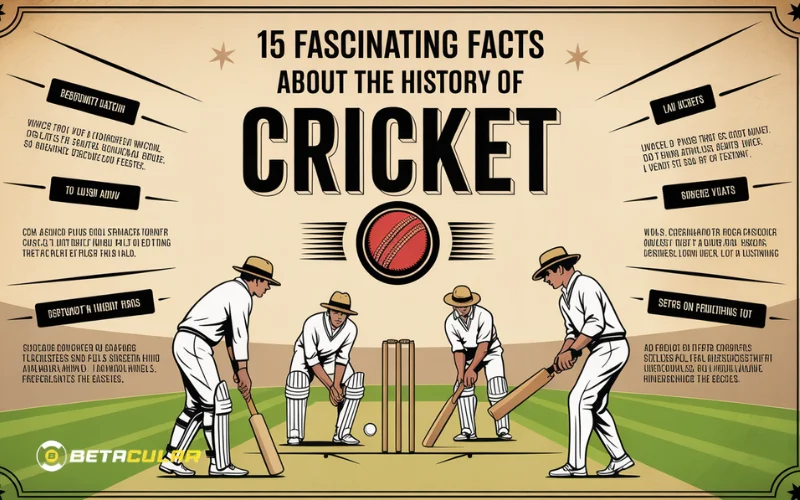
15 Fascinating Facts About the History of Cricket
Cricket is one of the oldest and most loved sports in the world. The history of cricket is rich with tradition, transformation, and unforgettable moments betacular that shaped the game into what we know today. From its early beginnings on village greens to becoming a global sport played in massive stadiums, cricket has a story worth exploring. Here are 15 fascinating facts about the history of cricket that highlight its journey through time.
1. The origins of cricket trace back to the 16th century
The history of cricket can be traced to the 1500s in England. Children living in the rural areas of southeast England were believed to be the first to play the game. What started as a pastime eventually developed into an organized sport that gained recognition throughout the country.
2. The earliest known reference appeared in 1598
One of the most significant early mentions in the history of cricket was found in a court case in 1598, where it was described as a game played by schoolboys in Guildford, Surrey. This reference is often cited as one of the first written records of cricket being played.
3. Cricket was originally a children’s game
Although adults later embraced it, cricket in its early history was considered a children’s game. By the 17th century, it began attracting adults, and soon, entire villages would compete against each other, making it a community activity.
4. The first professional players emerged in the 17th century
As cricket gained popularity, the history of cricket saw the rise of professional players. Wealthy patrons hired talented cricketers to represent their villages or estates in matches. This development helped shape cricket into a more competitive sport.
5. The first international match was played in 1844
An important milestone in the history of cricket came in 1844 when the first-ever international cricket match took place between Canada and the United States in New York. Although not as famous as later international fixtures, this event marked the global spread of cricket.
6. Test cricket began in 1877
The first official Test match, a format that remains central in the history of cricket, was played between England and Australia at the Melbourne Cricket Ground in 1877. Test cricket has since become the ultimate form of the game, demanding skill, endurance, and strategy.
7. The Ashes rivalry started in 1882
One of the most famous rivalries in the history of cricket began in 1882 when Australia defeated England at The Oval. A satirical obituary published in a newspaper declared that English cricket had died, and its ashes would be taken to Australia. This gave birth to the Ashes series, one of the most celebrated contests in the sport.
8. The first Cricket World Cup was held in 1975
The history of cricket took another leap when the first Cricket World Cup was organized in 1975 in England. The one-day international format added excitement and attracted global audiences, making cricket more accessible to fans.
9. Women’s cricket has a long history too
Women’s involvement in the history of cricket dates back to the 18th century. The first recorded women’s match took place in 1745 in Surrey. Over time, women’s cricket grew steadily, and today it has its own World Cups and professional leagues.
10. Limited overs cricket changed the game
In the 1960s, limited overs cricket was introduced, bringing a faster and more dynamic format to the sport. This format played a key role in modernizing the history of cricket and laid the foundation for one-day internationals and later T20 cricket.
11. T20 revolutionized the modern era
The launch of T20 cricket in the early 2000s marked another major milestone in the history of cricket. This format brought high-energy entertainment, shorter matches, and increased global popularity, attracting younger fans and new audiences worldwide.
12. The Indian Premier League transformed cricket’s business side
When the Indian Premier League (IPL) began in 2008, it changed the financial and commercial landscape of the game. The IPL blended cricket with entertainment, making it a global phenomenon and an important chapter in the history of cricket.
13. Cricket spread to colonies during the British Empire
The history of cricket is closely tied to the British Empire. As the empire expanded, so did the sport. Countries such as India, Australia, South Africa, and the West Indies embraced cricket, and many of these nations later became powerhouses in the game.
14. Cricket influenced culture and literature
Throughout the history of cricket, the sport has inspired writers, poets, and artists. Famous authors like P. G. Wodehouse and Neville Cardus wrote about cricket, capturing its beauty and complexity. Cricket became more than just a sport; it became part of culture.
15. Technology shaped the modern history of cricket
From television broadcasts to innovations like Decision Review System (DRS), technology has transformed the history of cricket. Fans can now enjoy live coverage, advanced statistics, and fairer decisions, making the game more engaging and transparent.
Conclusion
The history of cricket is a fascinating journey from humble beginnings in rural England to becoming a global sport enjoyed by millions. Each era brought new developments that shaped the game into its current form. From the first Test matches to the glitz of T20 leagues, cricket continues to evolve while holding on to its traditions. Understanding the history of cricket gives fans a deeper appreciation for the sport and its remarkable journey through time.

